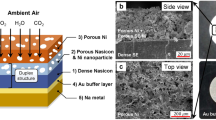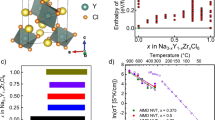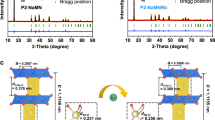Abstract
In the search for room-temperature batteries with high energy densities, rechargeable metal–air (more precisely metal–oxygen) batteries are considered as particularly attractive owing to the simplicity of the underlying cell reaction at first glance1. Atmospheric oxygen is used to form oxides during discharging, which—ideally—decompose reversibly during charging. Much work has been focused on aprotic Li–O2 cells (mostly with carbonate-based electrolytes and Li2O2 as a potential discharge product), where large overpotentials are observed and a complex cell chemistry is found2. In fact, recent studies evidence that Li–O2 cells suffer from irreversible electrolyte decomposition during cycling3. Here we report on a Na–O2 cell reversibly discharging/charging at very low overpotentials (< 200 mV) and current densities as high as 0.2 mA cm−2 using a pure carbon cathode without an added catalyst. Crystalline sodium superoxide (NaO2) forms in a one-electron transfer step as a solid discharge product. This work demonstrates that substitution of lithium by sodium may offer an unexpected route towards rechargeable metal–air batteries.
This is a preview of subscription content, access via your institution
Access options
Subscribe to this journal
Receive 12 print issues and online access
$259.00 per year
only $21.58 per issue
Buy this article
- Purchase on Springer Link
- Instant access to full article PDF
Prices may be subject to local taxes which are calculated during checkout




Similar content being viewed by others
References
Bruce, P. G., Freunberger, S. A., Hardwick, L. J. & Tarascon, J-M. Li–O2 and Li–S batteries with high energy storage. Nature Mater. 11, 19–29 (2012).
Freunberger, S. A. et al. Reactions in the rechargeable lithium–O2 battery with alkyl carbonate electrolytes. J. Am. Chem Soc. 133, 8040–8047 (2011).
McCloskey, B. D., Bethune, D. S., Shelby, R. M., Girishkumar, G. & Luntz, A. C. Solvents’ critical role in nonaqueous lithium–oxygen battery electrochemistry. J. Phys. Chem. Lett. 2, 1161–1166 (2011).
Abraham, K. M. & Jiang, Z. A polymer electrolyte-based rechargeable lithium/oxygen battery. J. Electrochem. Soc. 143, 1–5 (1996).
Lu, Y. C. et al. Platinum–gold nanoparticles: A highly active bifunctional electrocatalyst for rechargeable lithium–air batteries. J. Am. Chem. Soc. 132, 12170–12171 (2010).
Débart, A., Paterson, A. J., Bao, J. & Bruce, P. G. α-MnO2 nanowires: A catalyst for the O2 electrode in rechargeable lithium batteries. Angew. Chem. Int. Ed. 47, 4521–4524 (2008).
Garsuch, A. et al. Investigation of various ionic liquids and catalyst materials for lithium–oxygen batteries. Z. Phys. Chem. 226, 107–119 (2012).
Read, J. Characterization of the lithium/oxygen organic electrolyte battery. J. Electrochem. Soc. 149, A1190–A1196 (2002).
Sawyer, D. T. & Valentine, J. S. How super is superoxide? Acc. Chem. Res. 14, 393–400 (1981).
Aurbach, D., Daroux, M., Faguy, P. & Yeager, E. The electrochemistry of noble metal electrodes in aprotic organic solvents containing lithium salts. J. Electroanal. Chem. 297, 225–244 (1991).
Mizuno, F., Nakanishi, S., Kotani, Y., Yokoishi, S. & Iba, H. Rechargeable lithium–air batteries with carbonate-based liquid electrolytes. Electrochemistry 78, 403–405 (2010).
Black, R. et al. Screening for superoxide reactivity in Li–O2 batteries: effect on Li2O2/LiOH crystallization. J. Am. Chem. Soc. 134, 2902–2905 (2012).
McCloskey, B. D. et al. On the efficacy of electrocatalysis in nonaqueous Li–O2 batteries. J. Am. Chem. Soc. 133, 18038–18041 (2011).
Zhang, Z. et al. Increased stability toward oxygen reduction products for lithium–air batteries with oligoether-functionalized silane electrolytes. J. Phys. Chem. C 115, 25535–25543.
Ó Laoire, C., Mukerjee, S., Plichta, E. J., Hendrickson, M. A. & Abraham, K. M. Rechargeable lithium/TEGDME−LiPF6/O2 battery. J. Electrochem. Soc. 158, A302–A308 (2011).
Lu, Y-C. et al. The discharge rate capability of rechargeable Li–O2 batteries. Energy Environ Sci. 4, 2999–3007 (2011).
Sun, Q., Yang, Y. & Fu, Z-W. Electrochemical properties of room temperature sodium-air batteries with nonaqueous electrolyte. Electrochem. Commun. 16, 22–25 (2012).
Peled, E., Golodnitsky, D., Mazor, H., Goor, M. & Avshalomov, S. Parameter analysis of a practical lithium- and sodium-air electrical vehicle battery. J. Power Sources 196, 6835–6840 (2011).
Sangster, J. & Pelton, A. D. The Li–O (lithium–oxygen) system. J. Phase Equilib. 13, 296–299 (1992).
Wriedt, H. A. The Na–O (sodium–oxygen) system. Bull. Alloy Phase Diag. 8, 234–246 (1987).
Peng, Z. et al. Oxygen reactions in non-aqueous Li+ electrolyte. Angew. Chem. Int. Ed. 50, 6351–6355 (2011).
Freunberger, S. A. et al. The lithium-oxygen battery with ether-based electrolytes. Angew. Chem. Int. Ed. 50, 1–6 (2011).
Read, J. et al. Oxygen transport properties of organic electrolytes and performance of lithium/oxygen battery. J. Electrochem. Soc. 150, A1341–A1356 (2003).
Xia, C., Bender, C. L., Bergner, B., Peppler, K. & Janek, J. An electrolyte partially-wetted cathode improving oxygen diffusion in cathodes of non-aqueous Li–air batteries. Electrochem. Commun. 26, 93–96 (2013).
Viswanathan, V., Thygesen, K. S., Hummelshøj, J. S., Nørskov, J. K. & Girishkumar, G. Electrical conductivity in Li2O2 and its role in determining capacity limitations in non-aqueous Li–O2 batteries. J. Chem. Phys. 135, 214704 (2011).
Radin, M. D., Rodriguez, J. F., Tian, F. & Siegel, D. J. Lithium peroxide surfaces are metallic, while lithium oxide surfaces are not. J. Am. Chem. Soc. 143, 1093–1103 (2012).
Zhuravlev, Y. N., Kravchenko, N. G. & Obolonskaya, O. S. The electronic structure of alkali metal oxides. Russ. J. Phys. Chem. B 4, 20–28 (2010).
Khan, A. U. & Mahanti, S. D. Collective electron effects of O2− in potassium superoxide. J. Chem. Phys. 63, 2271–2278 (1975).
Bösch, M., Känzig, W. & Steigmeier, E. F. Molekül- und Gitterschwingungen in Natriumhyperoxid. Phys. Kondens. Materie 16, 107–112 (1973).
Carter, G. F. & Tempelton, D. H. Polymorphism of sodium superoxide. J. Am. Chem. Soc. 75, 5247–5249 (1953).
Ziegler, M., Roesenfeld, M., Känzig, W. & Fischer, P. Strukturuntersuchungen an alkalyhyperoxiden. Helv. Phys. Acta 49, 57–59 (1976).
Stephanou, S. E., Seyb, E. J., Kleinberg, J., Shakey, R. H & Schechter, W. H. Sodium superoxide. Inorg. Synth. 4, 82–85 (1953).
Schechter, W. H., Sisler, H. H. & Kleinberg, J. The adsorption of oxygen by sodium in liquid ammonia: Evidence of the existence of sodium superoxide. J. Am. Chem. Soc. 70, 267–269 (1948).
Peng, Z., Freunberger, S. A., Chen, Y. & Bruce, P. G. A reversible higher-rate Li–O2 battery. Science 337, 563–566 (2012).
Acknowledgements
The research was supported by the BASF International Scientific Network for Electrochemistry and Batteries. P. Hartmann is grateful to Fonds der chemischen Industrie (FCI) for a scholarship. The authors thank M. Ante, B. Jache and C. Raiß for experimental support. We further thank H. Heidt, H. Weigand, G. Pfeiffer and S. Lember for technical support. We are indebted to M. Jansen (Max-Planck-Institute for Solid State Research) for providing phase-pure bulk NaO2 as a reference material.
Author information
Authors and Affiliations
Contributions
P.A., P.H. and J.J. designed this study. P.H. and C.L.B. carried out the electrochemical experiments and XRD analysis. M.V. developed the metal–air cell set-up for the battery tests. P.H. developed the gas pressure set-up and conducted the SEM, EDS and Raman spectroscopy experiments. P.H., P.A. and J.J. analysed and discussed the results and wrote the manuscript. A.K.D. and A.G. contributed to the scientific discussion. P.A. and J.J. supervised the research project.
Corresponding authors
Ethics declarations
Competing interests
A US-Provisional Patent Application (US 61/615901) directed to sodium oxygen cells as described in the manuscript has been filed by BASF SE with the USPTO. A.K.D. and A.G. are employees of BASF SE.
Supplementary information
Supplementary Information
Supplementary Information (PDF 1446 kb)
Rights and permissions
About this article
Cite this article
Hartmann, P., Bender, C., Vračar, M. et al. A rechargeable room-temperature sodium superoxide (NaO2) battery. Nature Mater 12, 228–232 (2013). https://doi.org/10.1038/nmat3486
Received:
Accepted:
Published:
Issue Date:
DOI: https://doi.org/10.1038/nmat3486
This article is cited by
-
Design of a 3D mixed conducting scaffold toward stable metallic sodium anodes
Rare Metals (2022)
-
Rooting Zn into metallic Na bulk for energetic metal anode
Science China Materials (2022)
-
Quenching of magnetism in NaO2 due to electrostatic interaction induced partial orbital ordering
Journal of Molecular Modeling (2022)
-
Recent advances in NASICON-type oxide electrolytes for solid-state sodium-ion rechargeable batteries
Ionics (2022)
-
Achieving stable Na metal cycling via polydopamine/multilayer graphene coating of a polypropylene separator
Nature Communications (2021)



